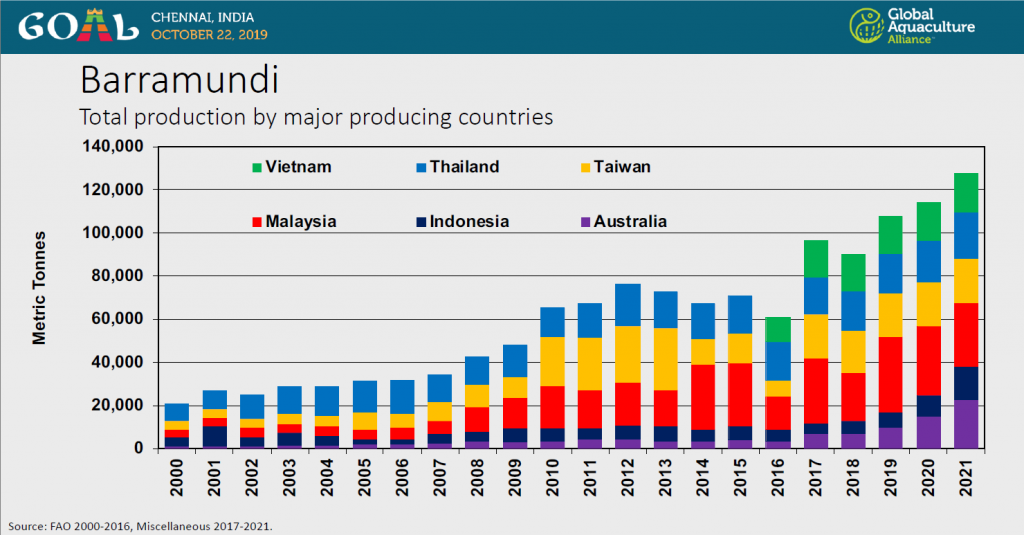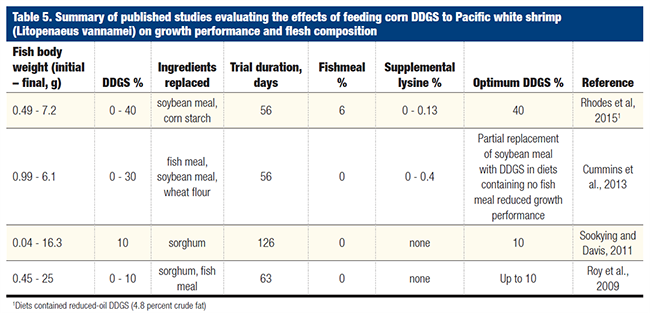The marine territory covered by the countries in Southeast Asia is about three times larger than the combined land area – a large reason why fish is the most popular and affordable protein source in the region. The U.S. Grains Council (USGC) is specifically targeting the aquaculture industry in Southeast Asia as one of the next big demand growth opportunities for U.S. dried distiller’s grains with solubles (DDGS).
According to an agricultural outlook from the Food and Agriculture Organization of the United Nations (FAO), aquaculture feed production is expected to grow 35 percent over the next decade. The majority of this growth is expected to come from Southeast Asia, where fish claim a 31 percent share in meat consumption, and exports of fish and fish products continue to increase.
“In Southeast Asia, access to water provides a natural environment for expansion in aquaculture production – and growing export markets are creating more demand for production,” said Caleb Wurth, USGC assistant director of Southeast Asia. “Fish provide an extremely efficient source of protein production. Furthermore, a concentrated feed allows for intensive farming, which reduces the stress on the region’s wild ecosystems.”

The primary limiting factor for DDGS use in aquaculture feed is a lack of data and familiarity with the feed ingredient. In the absence of experience, end-users have misconceptions about DDGS, including that use will yellow fillets, questions of whether or not they are halal (permitted for Muslim diets) and others – all of which the Council are working to dispel. As a result, current inclusion rates for DDGS are estimated between zero and five percent, on average. The Council’s Southeast Asian office’s technical training and on-the-ground engagement is breaking down these barriers.
“Until now, U.S. coarse grains and co-products have been under-utilized and under-considered feed rations for shrimp, tilapia and pangasius [a large catfish species native to Southeast Asia] – the region’s top species by volume,” Wurth said. “A combination of funding from USDA’s Market Access Program (MAP) and Agricultural Trade Promotion (ATP) program has allowed us to specifically target this amassing market.”
To help in this effort, the Council has hired a part-time consultant to help spearhead the aquaculture program. Ronnie Tan, a nutritionist by education, has more than 35 years of experience in the aquaculture supply chain and international marketing. In this role, he is developing and targeting technical education and trade servicing programs for aquaculture in Southeast Asia. The initial program is focusing on Vietnam, Thailand and Indonesia, with likely expansion into Malaysia, Myanmar and the Philippines in the future.
The Council kicked off its new aquaculture-focused venture with two seminars in January 2020 in Ho Chi Minh City, Vietnam, and Bangkok, Thailand, with nearly 100 customers participating.
The seminars focused on the inclusion of DDGS and high-protein DDGS in shrimp, fin fish and marine species. Local U.S.-trained Vietnamese and Thai aqua nutritionists conducted a technical segment during the seminars, in addition to a commercial segment led by Tan, Wurth and DDGS-producing USGC members.
“The Council’s aquaculture program will help end-users engage with global aquaculture experts, increase their familiarity with DDGS in aquaculture diets, dispel myths associated with its use and instill confidence that DDGS is an ingredient with low mycotoxins, high energy and quality protein,” Wurth said. “All of these activities will allow end-users to make informed decisions and increase the use of U.S. DDGS in their aquaculture operations.”
Success in raising inclusion rates to five percent for shrimp and marine fish and three percent for freshwater fish could result in 275,000 metric tons in additional demand for U.S. DDGS in a region already responsible for one-third of U.S. DDGS exports. Higher inclusion rates could up that consumption to between 500,000 to 1.25 million tons in the future.
Learn more about the Council’s work to promote DDGS in Southeast Asia.
About The U.S. Grains Council
The U.S. Grains Council develops export markets for U.S. barley, corn, sorghum and related products including distiller’s dried grains with solubles (DDGS) and ethanol. With full-time presence in 28 locations, the Council operates programs in more than 50 countries and the European Union. The Council believes exports are vital to global economic development and to U.S. agriculture’s profitability. Detailed information about the Council and its programs is online at www.grains.org.


